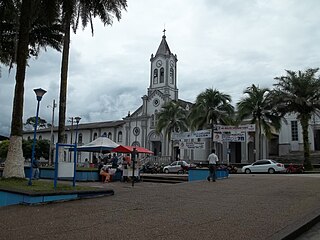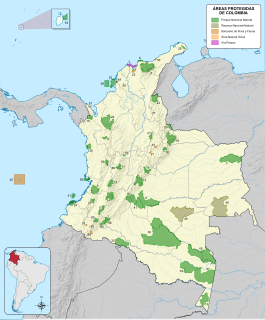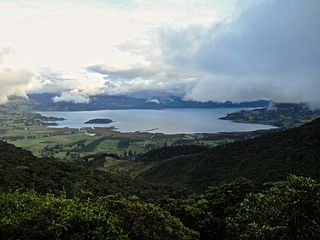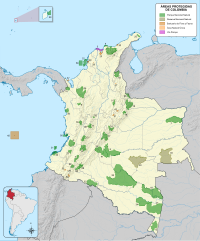
Nariño is a department of Colombia named after independence leader Antonio Nariño. Its capital is Pasto. It is in the west of the country, bordering Ecuador and the Pacific Ocean.

Putumayo is a department of Southern Colombia. It is in the south-west of the country, bordering Ecuador and Peru. Its capital is Mocoa.

Pasto, officially San Juan de Pasto, is the capital of the department of Nariño, in southern Colombia. The city has approximately 392,930 inhabitants and is located in the Atriz Valley on the Andes cordillera, at the foot of the Galeras volcano.

Mocoa is a municipality and capital city of the department of Putumayo in Colombia.

The Cofan people are an indigenous people native to Sucumbíos Province northeast Ecuador and to southern Colombia, between the Guamués River and the Aguarico River. Their total population is now only about 1,500 to 2,100 people, down from approximately 15,000 in the mid-16th century, when the Spanish crushed their ancient civilization, of which there are still some archeological remains. They speak the Cofán language or A'ingae. The ancestral land, community health and social cohesion of Cofan communities in Ecuador has been severely damaged by several decades of oil drilling. However, reorganization, campaigning for land rights, and direct action against encroaching oil installations have provided a modicum of stability. Major settlements include Sinangué, Dovuno, Dureno and Zábalo, the latter of which has retained a much more extensive land base.
The Amazon Conservation Team (ACT) is a non-profit organization that works in partnership with indigenous people of tropical South America in conserving the biodiversity of the Amazon rainforest, as well as the culture and land of its indigenous people. ACT was formed in 1996 by ethnobotanist Mark Plotkin and Costa Rican conservationist Liliana Madrigal. The organization is primarily active in the northwest, northeast, and southern regions of the Amazon.

The Colombian Massif, also known colloquially as Nudo de Almaguer, refers to a group of mountains within the Andes of south central Colombia. The massif is mainly within the area of the Cauca, Huila, and Nariño Departments. To the south is the Pasto Massif and to the north begins the Central and Eastern Andes.

Orito is a town and municipality in the Putumayo Department, Republic of Colombia. The town is just south of the confluence of the Patascoy and Luzonyaco Rivers. It is 43 kilometres (27 mi) north of the border with Ecuador.

Because of its natural structure, Colombia can be divided into six very distinct natural regions. These consist of the Andean Region, covering the three branches of the Andes mountains found in Colombia; the Caribbean Region, covering the area adjacent to the Caribbean Sea; the Pacific Region adjacent to the Pacific Ocean; the Orinoquía Region, part of the Llanos plains mainly in the Orinoco river basin along the border with Venezuela; the Amazon Region, part of the Amazon rainforest; and finally the Insular Region, comprising the islands in both the Atlantic and Pacific Oceans. Colombia is located in South America.

Bosque Seco del Patía Fauna and Flora Sanctuary, or Patia Dry Forest, is a wildlife sanctuary in Colombia. It is located on the border between the Nariño Department and the Cauca Department.
Santuario Orito Indí-Andé Fauna and Flora Sanctuary is a national park in Putumayo Department, Colombia

The Transandino pipeline is a 305-kilometre (190 mi) long crude oil pipeline, which transports oil from Orito, in the Department of Putumayo, to the Pacific port of Tumaco in the Department of Nariño, Colombia. The pipeline was built in 1969 with diameters of 10 inches (250 mm), 14 inches (360 mm) and 18 inches (460 mm). There are four pump stations and four reduce pressure stations. The pipeline has the capacity of 190,000 barrels per day (30,000 m3/d). It is operated by Ecopetrol.
Colombia Migration is Colombia's border control agency responsible for monitoring and conducting migratory control within the framework of national sovereignty and in accordance with the law.
Mónica Castaño Agudelo is a Colombian beauty queen and model.

Miguel Triana Ruiz de Cote was a Colombian engineer and Muisca scholar. He is best known for his 1922 publication La Civilización Chibcha; "The Muisca civilisation". Triana wrote a number of books about the Muisca and their culture. Miguel Triana especially contributed to the knowledge of the religion, society and the creation of rock art throughout the Muisca Confederation. Triana was the first Colombian investigator relating the Muisca culture with the pictographs. He described hundreds of rock paintings and carvings in his book El jeroglífico Chibcha.

Las Ánimas is a volcano of the Central Ranges of the Colombian Andes at the border of the departments of Cauca and Nariño. The volcano is 4,175 metres (13,698 ft) high.

La Cocha Lagoon is a 39,000-hectare (96,000-acre) volcanic crater lake located within the Pasto Municipality in Nariño, Colombia.

La Corota Island Flora Sanctuary is the smallest protected area of the Colombian National Natural Park System, covering just under 16 hectares of land and surrounding water area. Located on the Laguna de la Cocha, the flora sanctuary serves as a natural habitat for endemic sub-tropical Andean cloud forest plant species as well as a number of waterfowl, amphibians, and fish. Established as a flora and fauna sanctuary on June 6, 1977, La Corota Island has become one of the most visited national parks in Colombia having recorded 28,000 individual visitors in 2018.















